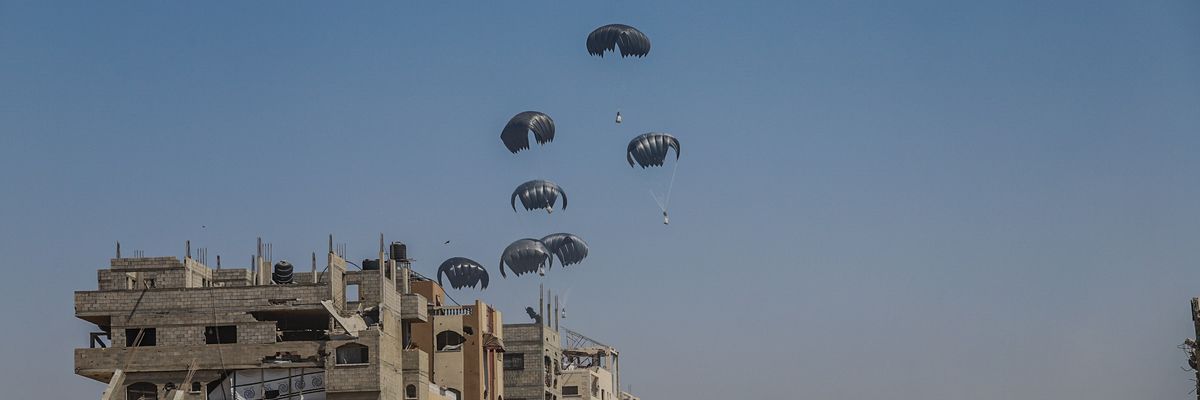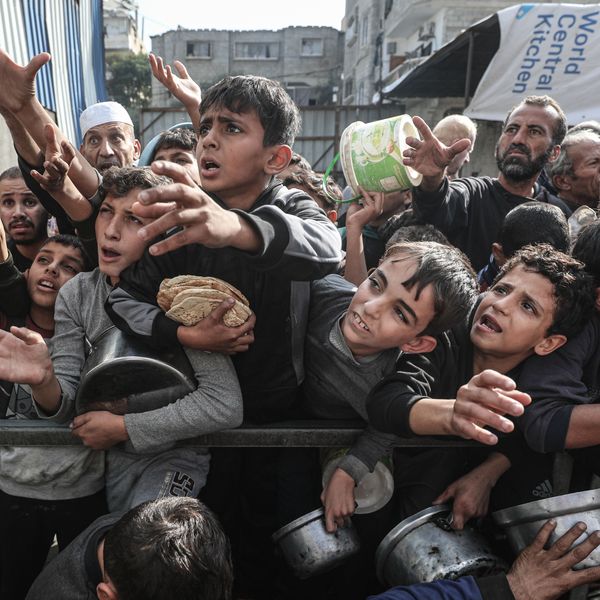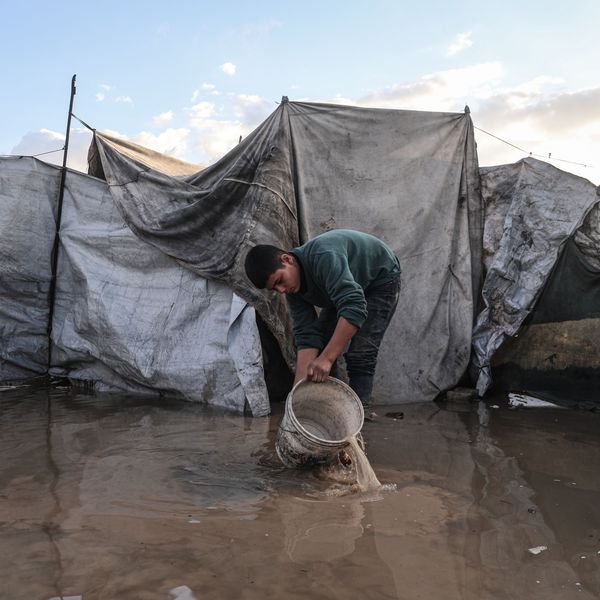
Palestinians receive humanitarian aid through the Zikim crossing as they return to their families near the Al-Sudaniya area in northern Gaza after the beginning of airdrop operations on July 27, 2025.
Starvation by Design: The Hidden Violence of Gaza’s Air-Dropped Aid
Now, even the delivery of aid has been weaponized, turned into a disorganized spectacle that fractures communities and deepens suffering.
In Gaza, food is not scarce because of drought or crop failure. It is scarce by design. And when you begin to see hunger as something engineered, not accidental, you begin to understand that starvation is not just a humanitarian failure. It is a form of violence.
Over the past several days, the Israeli military has resumed air-dropping humanitarian aid into Gaza. Videos of these operations have been released to the media, showing pallets of flour and canned goods drifting down on parachutes into the rubble of shattered neighborhoods. Seven pallets one day. Twenty-five tons another. These drops may sound like acts of compassion. But let’s look closer.
Gaza’s population, more than 2 million people, is now facing a full-blown famine in some regions. Experts estimate that Gaza requires around 64,000 cubic tons of food per month to meet basic nutritional needs. That comes to about 2,133 cubic tons of food per day. A single large truck typically carries about 3.3 cubic tons. So Gaza needs approximately 640 fully loaded food trucks crossing into the territory every single day to stabilize the situation.
Instead, what is arriving is a trickle of airdropped food, estimated at about 10 cubic tons per day. That is the equivalent of just three trucks’ worth of aid, less than one half of 1% of the daily requirement (0.05%).
If the daily need is 640 trucks and only three truck-equivalents are arriving, the deficit is not subtle. It is catastrophic.
This is not humanitarian relief. This is the illusion of relief. And worse, it is dangerous.
When pallets are dropped without warning, without organization, and without protection, they trigger desperation, violence, and trauma among people who are already on the edge of physical and emotional collapse. Civilians must run, fight, and risk injury or death just to get a single bag of flour. These scenes are not orderly distributions. They are chaotic scrambles that pit the starving against one another.
This is not relief. This is engineered chaos. This is what starvation warfare looks like in the modern age.
As an emergency physician who worked at Nasser Hospital in June, I saw the bodies that starvation produces. Children with visible ribs, swollen abdomens, and vacant eyes. Mothers who had not eaten in days, trying to nurse. Infants with no fat, no immunity, no chance. The human body in starvation mode turns on itself. Organs begin to fail. Cognition deteriorates. Children hallucinate. People become afraid of their own families. And still, they wait for aid that never comes.
When that aid finally does appear, drifting down from a plane without warning or order, it is not a lifeline. It is a provocation. It reinforces the trauma. It turns hunger into a contest. It is humiliation disguised as generosity.
We need to call this what it is. Starvation is a tactic. Blocking aid convoys, bulldozing bakeries, cutting off water and fuel, these are not accidents of war. They are deliberate tools of domination. And now, even the delivery of aid has been weaponized, turned into a disorganized spectacle that fractures communities and deepens suffering.
If the daily need is 640 trucks and only three truck-equivalents are arriving, the deficit is not subtle. It is catastrophic. And the chaos created by these paltry, random airdrops only increases the suffering of the population. This is not how you feed people. This is how you dehumanize them.
We must stop pretending that symbolic gestures are adequate. Gaza needs organized, large-scale, protected land convoys. It needs infrastructure and stability. It needs a cease-fire and a corridor for mass aid delivery. It needs the world to stop watching and start acting.
This is not just a humanitarian crisis.
It is a crime against humanity, unfolding in real time, with full visibility and full impunity
An Urgent Message From Our Co-Founder
Dear Common Dreams reader, The U.S. is on a fast track to authoritarianism like nothing I've ever seen. Meanwhile, corporate news outlets are utterly capitulating to Trump, twisting their coverage to avoid drawing his ire while lining up to stuff cash in his pockets. That's why I believe that Common Dreams is doing the best and most consequential reporting that we've ever done. Our small but mighty team is a progressive reporting powerhouse, covering the news every day that the corporate media never will. Our mission has always been simple: To inform. To inspire. And to ignite change for the common good. Now here's the key piece that I want all our readers to understand: None of this would be possible without your financial support. That's not just some fundraising cliche. It's the absolute and literal truth. We don't accept corporate advertising and never will. We don't have a paywall because we don't think people should be blocked from critical news based on their ability to pay. Everything we do is funded by the donations of readers like you. Will you donate now to help power the nonprofit, independent reporting of Common Dreams? Thank you for being a vital member of our community. Together, we can keep independent journalism alive when it’s needed most. - Craig Brown, Co-founder |
In Gaza, food is not scarce because of drought or crop failure. It is scarce by design. And when you begin to see hunger as something engineered, not accidental, you begin to understand that starvation is not just a humanitarian failure. It is a form of violence.
Over the past several days, the Israeli military has resumed air-dropping humanitarian aid into Gaza. Videos of these operations have been released to the media, showing pallets of flour and canned goods drifting down on parachutes into the rubble of shattered neighborhoods. Seven pallets one day. Twenty-five tons another. These drops may sound like acts of compassion. But let’s look closer.
Gaza’s population, more than 2 million people, is now facing a full-blown famine in some regions. Experts estimate that Gaza requires around 64,000 cubic tons of food per month to meet basic nutritional needs. That comes to about 2,133 cubic tons of food per day. A single large truck typically carries about 3.3 cubic tons. So Gaza needs approximately 640 fully loaded food trucks crossing into the territory every single day to stabilize the situation.
Instead, what is arriving is a trickle of airdropped food, estimated at about 10 cubic tons per day. That is the equivalent of just three trucks’ worth of aid, less than one half of 1% of the daily requirement (0.05%).
If the daily need is 640 trucks and only three truck-equivalents are arriving, the deficit is not subtle. It is catastrophic.
This is not humanitarian relief. This is the illusion of relief. And worse, it is dangerous.
When pallets are dropped without warning, without organization, and without protection, they trigger desperation, violence, and trauma among people who are already on the edge of physical and emotional collapse. Civilians must run, fight, and risk injury or death just to get a single bag of flour. These scenes are not orderly distributions. They are chaotic scrambles that pit the starving against one another.
This is not relief. This is engineered chaos. This is what starvation warfare looks like in the modern age.
As an emergency physician who worked at Nasser Hospital in June, I saw the bodies that starvation produces. Children with visible ribs, swollen abdomens, and vacant eyes. Mothers who had not eaten in days, trying to nurse. Infants with no fat, no immunity, no chance. The human body in starvation mode turns on itself. Organs begin to fail. Cognition deteriorates. Children hallucinate. People become afraid of their own families. And still, they wait for aid that never comes.
When that aid finally does appear, drifting down from a plane without warning or order, it is not a lifeline. It is a provocation. It reinforces the trauma. It turns hunger into a contest. It is humiliation disguised as generosity.
We need to call this what it is. Starvation is a tactic. Blocking aid convoys, bulldozing bakeries, cutting off water and fuel, these are not accidents of war. They are deliberate tools of domination. And now, even the delivery of aid has been weaponized, turned into a disorganized spectacle that fractures communities and deepens suffering.
If the daily need is 640 trucks and only three truck-equivalents are arriving, the deficit is not subtle. It is catastrophic. And the chaos created by these paltry, random airdrops only increases the suffering of the population. This is not how you feed people. This is how you dehumanize them.
We must stop pretending that symbolic gestures are adequate. Gaza needs organized, large-scale, protected land convoys. It needs infrastructure and stability. It needs a cease-fire and a corridor for mass aid delivery. It needs the world to stop watching and start acting.
This is not just a humanitarian crisis.
It is a crime against humanity, unfolding in real time, with full visibility and full impunity
- Killing Palestinians by Blocking Aid. Killing Palestinians by Airdropping Aid. ›
- 'A Cruel and Transparent Farce': Israeli Attacks Kill 62 in Gaza Amid 'Tactical Pause' ›
- 12 Palestinians Drown Trying to Retrieve Airdropped Gaza Aid From Sea ›
- Biden Admin Airdrops 38,000 Meals Into Gaza as US-Armed Israeli Military Starves Millions ›
- Opinion | Worse Than Fiction: Responding to a Mass Casualty Event in Gaza | Common Dreams ›
In Gaza, food is not scarce because of drought or crop failure. It is scarce by design. And when you begin to see hunger as something engineered, not accidental, you begin to understand that starvation is not just a humanitarian failure. It is a form of violence.
Over the past several days, the Israeli military has resumed air-dropping humanitarian aid into Gaza. Videos of these operations have been released to the media, showing pallets of flour and canned goods drifting down on parachutes into the rubble of shattered neighborhoods. Seven pallets one day. Twenty-five tons another. These drops may sound like acts of compassion. But let’s look closer.
Gaza’s population, more than 2 million people, is now facing a full-blown famine in some regions. Experts estimate that Gaza requires around 64,000 cubic tons of food per month to meet basic nutritional needs. That comes to about 2,133 cubic tons of food per day. A single large truck typically carries about 3.3 cubic tons. So Gaza needs approximately 640 fully loaded food trucks crossing into the territory every single day to stabilize the situation.
Instead, what is arriving is a trickle of airdropped food, estimated at about 10 cubic tons per day. That is the equivalent of just three trucks’ worth of aid, less than one half of 1% of the daily requirement (0.05%).
If the daily need is 640 trucks and only three truck-equivalents are arriving, the deficit is not subtle. It is catastrophic.
This is not humanitarian relief. This is the illusion of relief. And worse, it is dangerous.
When pallets are dropped without warning, without organization, and without protection, they trigger desperation, violence, and trauma among people who are already on the edge of physical and emotional collapse. Civilians must run, fight, and risk injury or death just to get a single bag of flour. These scenes are not orderly distributions. They are chaotic scrambles that pit the starving against one another.
This is not relief. This is engineered chaos. This is what starvation warfare looks like in the modern age.
As an emergency physician who worked at Nasser Hospital in June, I saw the bodies that starvation produces. Children with visible ribs, swollen abdomens, and vacant eyes. Mothers who had not eaten in days, trying to nurse. Infants with no fat, no immunity, no chance. The human body in starvation mode turns on itself. Organs begin to fail. Cognition deteriorates. Children hallucinate. People become afraid of their own families. And still, they wait for aid that never comes.
When that aid finally does appear, drifting down from a plane without warning or order, it is not a lifeline. It is a provocation. It reinforces the trauma. It turns hunger into a contest. It is humiliation disguised as generosity.
We need to call this what it is. Starvation is a tactic. Blocking aid convoys, bulldozing bakeries, cutting off water and fuel, these are not accidents of war. They are deliberate tools of domination. And now, even the delivery of aid has been weaponized, turned into a disorganized spectacle that fractures communities and deepens suffering.
If the daily need is 640 trucks and only three truck-equivalents are arriving, the deficit is not subtle. It is catastrophic. And the chaos created by these paltry, random airdrops only increases the suffering of the population. This is not how you feed people. This is how you dehumanize them.
We must stop pretending that symbolic gestures are adequate. Gaza needs organized, large-scale, protected land convoys. It needs infrastructure and stability. It needs a cease-fire and a corridor for mass aid delivery. It needs the world to stop watching and start acting.
This is not just a humanitarian crisis.
It is a crime against humanity, unfolding in real time, with full visibility and full impunity
- Killing Palestinians by Blocking Aid. Killing Palestinians by Airdropping Aid. ›
- 'A Cruel and Transparent Farce': Israeli Attacks Kill 62 in Gaza Amid 'Tactical Pause' ›
- 12 Palestinians Drown Trying to Retrieve Airdropped Gaza Aid From Sea ›
- Biden Admin Airdrops 38,000 Meals Into Gaza as US-Armed Israeli Military Starves Millions ›
- Opinion | Worse Than Fiction: Responding to a Mass Casualty Event in Gaza | Common Dreams ›

